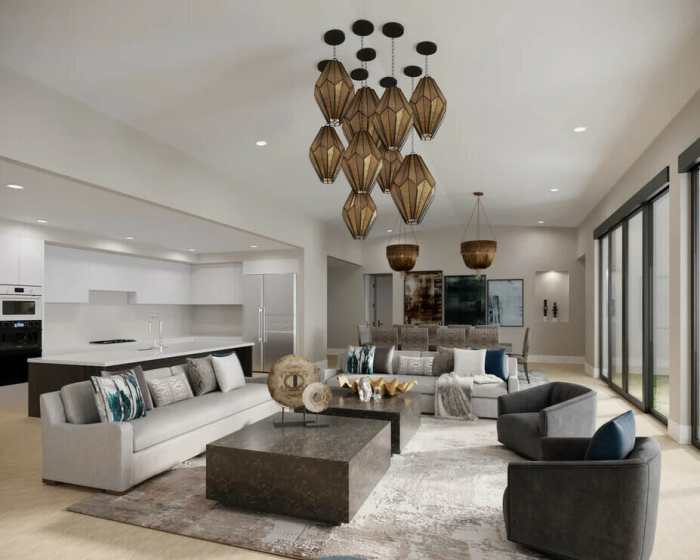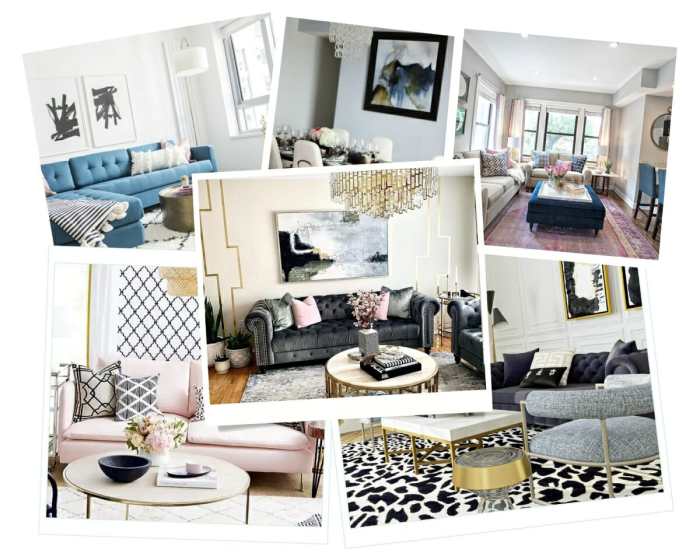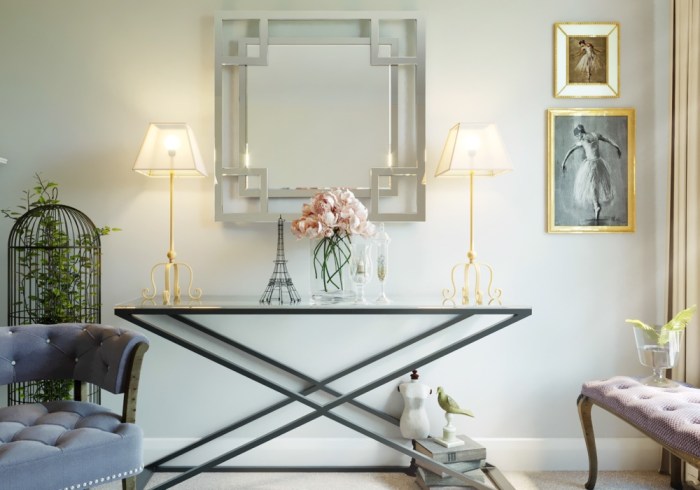Interior Styling Secrets from Global Design Experts sets the stage for this enthralling narrative, offering readers a glimpse into a story that is rich in detail and brimming with originality from the outset. From exploring global design trends to incorporating sustainable practices, this topic delves deep into the fascinating world of interior design.
As we dive into the key elements of interior styling, sustainable practices, color psychology, textures, patterns, and lighting techniques, get ready to uncover the secrets that top design experts worldwide use to create stunning spaces.
Explore Global Design Trends

When it comes to interior styling, different countries have distinct elements that reflect their unique culture and heritage. Exploring global design trends allows us to appreciate the diversity in aesthetics and understand how cultural influences shape design choices.
Key Elements of Interior Styling from Different Countries
- Japanese design often focuses on simplicity, natural materials, and minimalism, inspired by Zen philosophy.
- Moroccan interiors feature vibrant colors, intricate patterns, and luxurious textiles, reflecting the rich heritage of the region.
- Scandinavian design emphasizes functionality, clean lines, and a connection to nature, creating spaces that are both cozy and modern.
Comparing and Contrasting Design Aesthetics from Various Cultures
- While Japanese and Scandinavian design both prioritize simplicity, the former leans towards a more Zen-inspired minimalism, while the latter embraces a cozy and warm aesthetic.
- In contrast, Moroccan design stands out with its bold use of colors and intricate patterns, creating a vibrant and welcoming atmosphere.
Impact of Cultural Influences on Interior Design Choices
- Cultural influences play a significant role in shaping interior design choices, as they reflect traditions, values, and lifestyle preferences of a particular region.
- By understanding how different cultures approach design, we can appreciate the beauty of diversity and draw inspiration from global trends to create unique and personalized spaces.
Incorporate Sustainable Practices in Interior Styling
When it comes to interior styling, incorporating sustainable practices is not only a trend but a necessity in today's design world. Global design experts are leading the way in implementing eco-friendly techniques that not only benefit the environment but also create beautiful and functional spaces.
Using sustainable materials in interior design not only reduces the carbon footprint but also promotes a healthier living environment for occupants. Let's explore some of the sustainable design techniques used by global experts and the importance of incorporating sustainability in interior styling.
Examples of Sustainable Materials and Their Benefits
- Bamboo: A fast-growing and renewable resource that is durable and versatile, making it ideal for flooring, furniture, and decor items.
- Recycled Glass: Used in countertops, tiles, and decorative accents, recycled glass reduces waste in landfills and adds a unique touch to any space.
- Cork: Harvested from the bark of cork oak trees without harming them, cork is a sustainable material used for flooring, wall coverings, and furniture.
Importance of Incorporating Sustainability in Interior Styling
Integrating sustainable practices in interior styling not only helps in conserving natural resources but also contributes to a healthier and more energy-efficient living environment. By choosing eco-friendly materials and design techniques, designers can create spaces that are not only visually appealing but also environmentally responsible.
Utilize Color Psychology in Interior Design

Color plays a crucial role in setting the mood and atmosphere of a space. Different colors can evoke various emotions and feelings, impacting how people perceive and interact with their surroundings. In interior design, understanding color psychology can help create harmonious and inviting spaces that cater to the needs and preferences of the inhabitants.
Effects of Colors on Mood and Atmosphere
- Warm colors like red, orange, and yellow can create a cozy and energetic atmosphere, perfect for social spaces like living rooms or dining areas.
- Cool colors such as blue, green, and purple promote a sense of calm and relaxation, making them ideal for bedrooms or home offices.
- Neutral colors like beige, gray, and white provide a versatile backdrop that can be easily paired with bolder hues or accents to add visual interest.
Color Trends in Interior Styling
- In North America, earthy tones and warm neutrals are popular choices for creating a welcoming and timeless look.
- In Europe, jewel tones and deep shades like emerald green and sapphire blue are trending, adding a touch of luxury and sophistication to interiors.
- In Asia, pastel colors and soft hues are favored for their calming and serene qualities, reflecting a minimalist and modern aesthetic.
Tips for Selecting the Right Color Palette
- Consider the function of the room and the mood you want to evoke before choosing a color scheme.
- Take into account natural light and the room's orientation to ensure the colors appear as intended under different lighting conditions.
- Experiment with sample swatches or virtual tools to visualize how different colors will look together before making a final decision.
Embrace Textures and Patterns

Textures and patterns play a crucial role in interior design by adding depth, visual interest, and personality to a room. When used effectively, they can create a sense of balance, harmony, and sophistication in the space.
Global Design Experts’ Effective Use of Textures and Patterns
- Layering Different Textures: Global design experts often layer different textures such as velvet, linen, wool, and leather to create a rich and inviting space. This adds dimension and tactile appeal to the room.
- Mixing Patterns: Experts seamlessly mix patterns like stripes, florals, geometric prints, and abstract designs to add visual interest without overwhelming the space. They often follow the rule of combining large, medium, and small-scale patterns for a balanced look.
- Utilizing Natural Elements: Incorporating natural textures like wood, stone, and plants can bring warmth and organic feel to a room. Design experts often use these elements to create a connection to nature and enhance the overall aesthetic.
Tips for Mixing Textures and Patterns
- Stick to a Color Palette: When mixing textures and patterns, it's essential to stick to a cohesive color palette to ensure a harmonious look. Choose colors that complement each other and create a cohesive visual flow.
- Vary Scale and Proportion: Experiment with different scales and proportions of textures and patterns to create contrast and visual interest. Pair large-scale patterns with smaller textures for a dynamic look.
- Consider the Room's Function: Tailor your choice of textures and patterns based on the room's function. For example, opt for soft and cozy textures in a bedroom and more durable patterns in high-traffic areas like the living room.
Optimize Lighting Techniques for Different Spaces
Lighting plays a crucial role in interior styling as it can enhance the ambiance, highlight key features, and create a functional space. Design experts around the world have been using innovative lighting solutions to transform interiors and elevate the overall design aesthetic.
Choosing the right lighting fixtures for various rooms is essential to ensure proper illumination and complement the overall design scheme.
Innovative Lighting Solutions
- Utilizing smart lighting systems that allow for custom settings and control through mobile devices.
- Incorporating LED strip lights to create ambient lighting and highlight architectural elements.
- Installing pendant lights with adjustable heights to add visual interest and flexibility in lighting design.
Choosing the Right Lighting Fixtures
- Consider the function of the space and the activities that will take place when selecting lighting fixtures.
- Ensure proper lighting levels for tasks such as reading or cooking by incorporating task lighting in specific areas.
- Mix different types of lighting, including ambient, task, and accent lighting, to create a layered lighting effect.
- Take into account the size of the room and the ceiling height when choosing the scale and placement of lighting fixtures.
Final Wrap-Up
In conclusion, Interior Styling Secrets from Global Design Experts opens up a world of possibilities for anyone looking to elevate their interior design game. By incorporating elements from different cultures, embracing sustainability, understanding color psychology, experimenting with textures and patterns, and optimizing lighting, you too can create spaces that are not just beautiful but also functional and meaningful.
Let these secrets inspire your next design project and watch as your space transforms into a true work of art.
Key Questions Answered
How do cultural influences impact interior design choices?
Cultural influences play a significant role in interior design choices by shaping the aesthetics, color palettes, and overall feel of a space. By incorporating elements from different cultures, designers can create unique and personalized interiors.
Why is incorporating sustainability important in interior styling?
Incorporating sustainability in interior styling is crucial as it not only helps in reducing environmental impact but also promotes healthier living spaces. By using eco-friendly materials and practices, designers can create spaces that are both beautiful and sustainable.
How can colors affect mood and atmosphere in a space?
Colors have the power to evoke emotions and set the tone for a space. Warm colors like red and orange can create a cozy atmosphere, while cool colors like blue and green can induce a sense of calmness and relaxation.







